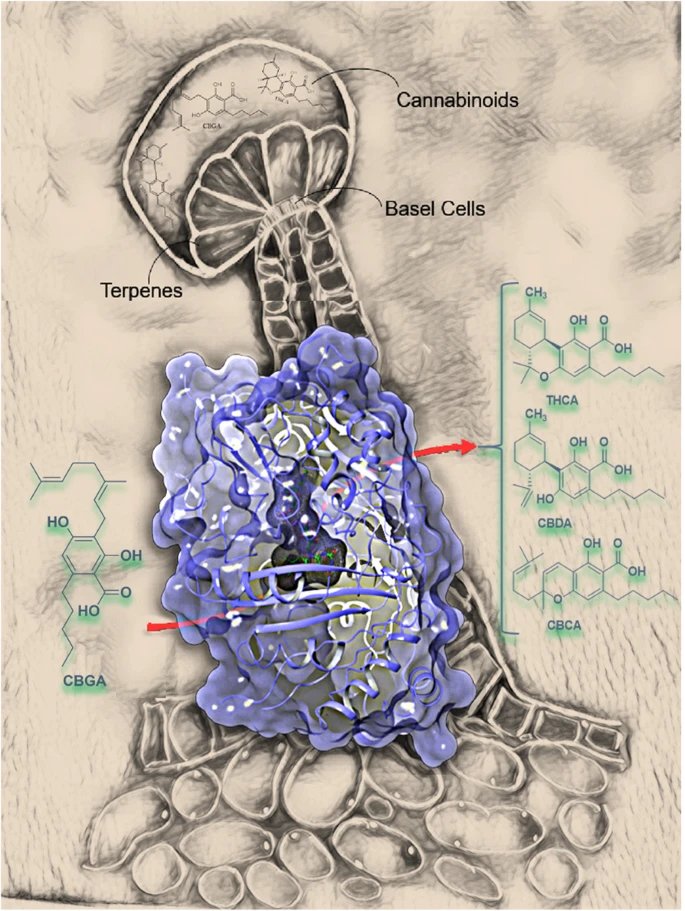THCP: The Next Frontier in Cannabinoid Science and Its Implications
THCP, an ultra-potent cannabinoid discovered in 2019, is reshaping cannabis science with its extraordinary receptor affinity and groundbreaking therapeutic potential.
Few discoveries in cannabis have generated as much scientific interest as tetrahydrocannabiphorol, commonly known as THCP. This relatively new cannabinoid, first identified by Italian researchers in 2019, is challenging everything we thought we knew about cannabis potency and therapeutic potential.
Unlike its well-known cousin THC (tetrahydrocannabinol), THCP features a seven-carbon alkyl side chain instead of THC's five-carbon structure. This seemingly minor molecular distinction creates profound differences in how the compound interacts with the human body.
The discovery of THCP represents a significant breakthrough in cannabis science, potentially explaining why some cannabis varieties produce stronger effects than their THC content alone would suggest.
As researchers continue exploring its properties, THCP may fundamentally alter our understanding of cannabinoid pharmacology and therapeutic applications.
The Science Behind THCP's Remarkable Potency
At the molecular level, THCP's extended alkyl side chain dramatically enhances its ability to bind with cannabinoid receptors throughout the body. This structural feature allows THCP to form a stronger connection with the CB1 receptor—the primary receptor responsible for psychoactive effects in the brain and central nervous system.
Laboratory studies indicate THCP binds to CB1 receptors with an affinity up to 33 times stronger than traditional THC. The cannabinoid also demonstrates significant binding to CB2 receptors, which are primarily associated with immune function and inflammation regulation.
"This substantially higher binding affinity explains why THCP produces more intense effects at much lower concentrations," explains Dr. Paolo Rovelli, who participated in the initial research published in Scientific Reports. "It's not just a slightly stronger version of THC—it represents an entirely different magnitude of potency."
This dramatic difference in receptor activation may explain why some cannabis strains with moderate THC levels can produce unexpectedly powerful effects. If these varieties contain even trace amounts of THCP, the combined effect could be substantially stronger than THC content alone would predict.
The compound's metabolism follows pathways similar to other cannabinoids, but its increased receptor binding efficiency means that even small concentrations can produce significant biological responses. Current research suggests THCP remains bioavailable in the body longer than standard THC, potentially extending both its therapeutic benefits and psychoactive effects.
Therapeutic Potential and Effects Profile
THCP's heightened potency presents both opportunities and challenges for medical applications. Early research suggests the cannabinoid demonstrates enhanced analgesic (pain-relieving) properties compared to THC, potentially offering relief at significantly lower doses.
Users and preliminary studies report THCP produces pronounced sedative effects, making it a promising candidate for treating insomnia and sleep disorders. Additionally, research indicates potent anti-inflammatory activity, which could benefit patients with conditions like rheumatoid arthritis, inflammatory bowel disease and multiple sclerosis.
However, the compound's strength demands careful consideration. THCP's dramatically increased potency means consumers may experience stronger psychoactive effects than anticipated, potentially leading to anxiety, discomfort or impairment if not properly dosed.
"The therapeutic window—the gap between an effective dose and an uncomfortable one—appears narrower with THCP than with traditional THC," notes cannabis researcher Dr. Ethan Russo. "This presents challenges for medical applications but also opportunities for creating more precisely targeted formulations."
For medical patients seeking cannabinoid therapy without intoxication, these potency differences matter tremendously. Future THCP-based medications would likely require significantly different dosing protocols than current THC-based treatments.
Natural Occurrence and Production Methods
Unlike major cannabinoids like THC and CBD, THCP appears naturally in cannabis plants only in trace amounts—typically less than 0.1% by dry weight. This scarcity explains why its discovery came relatively late in cannabis research history, requiring advanced analytical techniques to detect and isolate.
Scientists have identified slightly higher THCP concentrations in certain landrace varieties, particularly those originating from Central Asia. This has sparked interest in selective breeding programs aimed at developing strains with naturally elevated THCP levels.
Given its limited natural abundance, commercial THCP products primarily rely on laboratory synthesis or semi-synthetic production methods. These techniques typically start with CBD extracted from hemp, which undergoes chemical conversion to create THCP.
This production pathway raises important ethical and regulatory questions. Unlike naturally occurring plant compounds, synthesized cannabinoids exist in a murky legal territory and may not benefit from the regulatory exemptions granted to certain cannabis-derived substances.
Navigating the THCP Legal Landscape
The rapid emergence of THCP products has outpaced regulatory frameworks, creating considerable legal uncertainty. At the federal level, THCP's legal status remains complicated—though not explicitly scheduled as a controlled substance, it could potentially fall under the Federal Analogue Act as a THC derivative.
State laws vary dramatically, with some explicitly regulating THCP while others remain silent on the compound. This patchwork of regulations creates significant compliance challenges for manufacturers and retailers operating across multiple jurisdictions.
Hemp-derived THCP occupies a particularly ambiguous position. While the 2018 Farm Bill legalized hemp and its derivatives, the DEA has clarified that synthetically derived tetrahydrocannabinols remain Schedule I controlled substances regardless of source material.
"The legal distinction often hinges on whether THCP is considered 'naturally occurring' or 'synthetically derived,'" explains cannabis attorney Rod Kight. "This creates significant uncertainty for businesses, as production methods rather than the molecule itself may determine legality."
Internationally, few countries have established specific regulations for THCP. Most jurisdictions either regulate it under existing cannabis laws or have yet to address it specifically. This regulatory lag has created both opportunities and risks for international commerce in THCP products.
The Emerging THCP Marketplace
Despite legal uncertainties, THCP-infused products have rapidly entered the consumer marketplace. Vape cartridges containing THCP distillate were among the first offerings, followed by tinctures, edibles and concentrates marketed for both recreational and wellness purposes.
These products typically command premium prices compared to conventional THC formulations, with marketing often emphasizing THCP's enhanced potency and unique effects profile. Consumer interest has grown steadily as awareness of the cannabinoid spreads through cannabis communities and publications.
However, the THCP market faces significant challenges in standardization and quality control. No established testing protocols exist specifically for THCP, leading to inconsistent potency measurements and labeling practices. Some products marketed as THCP may contain minimal amounts of the compound or substitute other cannabinoids entirely.
Industry watchdogs have raised concerns about misinformation regarding THCP's effects and safety profile. Without standardized testing methods, consumers have limited ways to verify product contents or appropriate dosing guidelines.
The current market resembles the early CBD boom, with a mix of legitimate companies and opportunistic actors. Until regulatory standards catch up, consumers should approach THCP products with appropriate caution and research.
Future Research Horizons
The scientific community has only begun exploring THCP's full potential and implications. Researchers have identified several critical areas requiring further investigation, including:
Long-term safety profiles and potential drug interactions
Specific therapeutic applications where THCP might outperform existing cannabinoid treatments
Interactions between THCP and other cannabis compounds within the entourage effect
Development of standardized testing methodologies for accurate potency measurement
Optimal delivery systems for medical applications
THCP's discovery also raises intriguing questions about how many other unknown cannabinoids might exist in cannabis plants, waiting to be identified and studied. The plant contains over 140 known cannabinoids, but technological limitations have historically focused research on the most abundant compounds.
"THCP exemplifies why continued basic research into cannabis chemistry matters," says Dr. Linda Klumpers, pharmacologist and cannabis researcher. "We're still discovering fundamental aspects of a plant humans have used for thousands of years."
As research advances, THCP could potentially transform therapeutic cannabis applications. Its dramatically higher potency could enable smaller doses, alternative delivery methods, and more precisely targeted formulations for specific medical conditions.
The Future of THCP and Cannabis Science
The discovery of THCP represents more than just another cannabinoid—it signals a fundamental shift in our understanding of cannabis pharmacology. This ultra-potent compound challenges researchers to reconsider basic assumptions about how cannabinoids interact with the human body and what additional compounds might still await discovery.
For consumers, THCP offers both opportunities and risks. Its enhanced potency provides options for those seeking stronger effects from smaller doses, but also increases the importance of accurate labeling, informed consumption, and responsible use.
The medical cannabis community stands to gain significantly from further THCP research. More potent cannabinoids could potentially address treatment challenges in conditions that respond inadequately to current cannabis-based therapies, particularly in areas like neuropathic pain, treatment-resistant epilepsy, and inflammatory disorders.
As science, industry and regulation continue evolving around THCP, one thing remains clear: this remarkable cannabinoid represents just the beginning of a new chapter in cannabis research. With advanced analytical techniques continuing to uncover new compounds, the full therapeutic potential of the cannabis plant may be far greater than previously imagined.
For researchers, clinicians, industry participants and consumers alike, staying informed about THCP and emerging cannabinoid science will be essential to navigating the rapidly changing landscape of cannabis medicine and policy in the years ahead.
***
Marijuana Doctor is your premier destination for seamless medical marijuana licensing. Our compassionate team guides you with expertise, ensuring a smooth process. Discover the therapeutic benefits in a supportive environment that prioritizes your well-being.
Join a community championing alternative healing methods for a healthier life. Choose Marijuana Doctor for personalized, patient-centered care, and step into a revitalized future.
Follow us on Instagram!


